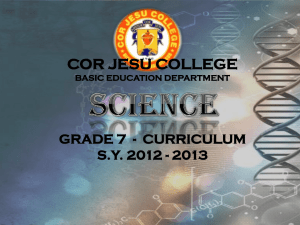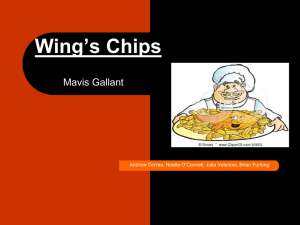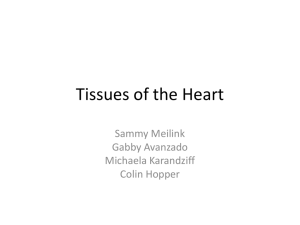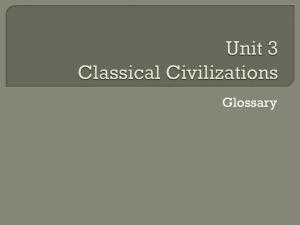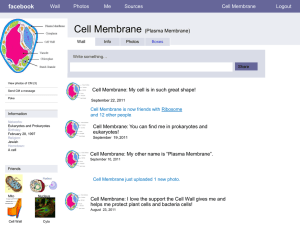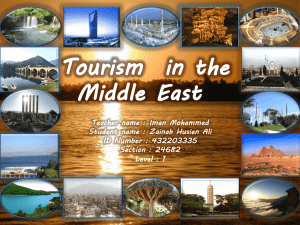UbD Stage 2 - Region 7 Professional Development Support
advertisement
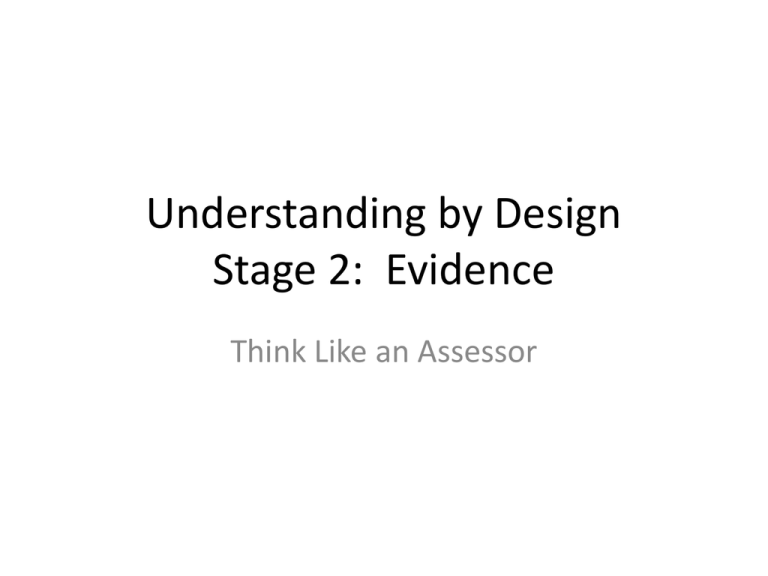
Understanding by Design Stage 2: Evidence Think Like an Assessor http://rt3region7.ncdpi.wikispaces.net Backward Design: Stage 2 • Performance Tasks and Rubrics • Other Evidence • Self-Assessment • To what extent do the assessments provide valid, reliable, and sufficient measures of the desired results? Pre-Assessment Reflection Questions • What patterns do you notice? • What generalizations can you make about your own classroom? Your grade-level or department? Your school? Your district? • What may be an area for improvement? Heidi Hayes Jacobs: What year are we preparing our students for? http://goo.gl/udjmU Video Viewing Guide Think-Pair-Share • What observations did you have while watching this talk? • Paradigm Shift • What will it take to get to the point of developing assessments as Jacobs suggests? Assessment vs. Evidence • What’s the difference? • Think-Pair-Share Assessment vs. Evidence • What’s the difference? • Think-Pair-Share • Evidence is… – collected over time instead of a single event – ongoing and frequent to catch misunderstandings in the early stages – Includes a wide range of different types of assessments Three Basic Questions 1) What kinds of evidence do we need to find hallmarks of our goals, including that of understanding? 2) What specific characteristics in the student responses, products, or performances should we examine to determine the extent to which the desired results were achieved? 3) Does the proposed evidence enable us to infer a student’s knowledge or understanding? Exercises to Support Deep Understanding • Ensure that teachers consider the intent of the standards • Facilitate conversations with other teachers to help reduce misconceptions • How should each standard or group of standards be assessed? http://www.google.com/imgres?q=collaboration&hl=en&client=firefox-a&rls=org.mozilla:enUS:official&biw=1366&bih=664&tbm=isch&tbnid=iWwNZpAHR8ZSyM:&imgrefurl=http://www.thevarguy.com/2011/04/13/visual-collaboration-the-nextvar-opportunity-arrives/&docid=caP-BUJSvM5wOM&imgurl=http://www.thevarguy.com/wpcontent/uploads/2011/04/collaboration.jpg&w=371&h=323&ei=IpgET9bZMYeXtwf82f20CA&zoom=1&iact=hc&vpx=331&vpy=322&dur=320&hovh=209&ho vw=241&tx=129&ty=96&sig=114730900127101918374&page=1&tbnh=139&tbnw=143&start=0&ndsp=19&ved=1t:429,r:7,s:0 Collection of Evidence Assessment Understanding Stage 2: Evidence http://www.google.com/imgres?q=think+clipart&start=484&num=10&hl=en&client=firefox-a&rls=org.mozilla:enUS:official&biw=1366&bih=664&tbm=isch&tbnid=4IlRKZhxKjkC6M:&imgrefurl=http://fidolew.blogspot.com/2010_08_01_archive.html&docid=APUIdeRwTl6jrM&imgurl=http://2.bp.blogspot.com/_bP5JHTTWjIM/THnkNQvZDhI/AAAAAAAAArA/rLbUpG06h4s/s1600 /6a00d8341e626f53ef0115712117e1970c800wi.jpg&w=800&h=551&ei=lLwJT9jEF82ltwe6ttneAQ&zoom=1&chk=sbg&iact=hc&vpx=822&vpy=203&dur=154&hovh=186&hovw=271&tx=145&ty=85&sig=114730900127 101918374&sqi=2&page=23&tbnh=109&tbnw=158&ndsp=22&ved=1t:429,r:12,s:484 Changing the Paradigm about Quality Evidence and Assessment http://pics.blameitonthevoices.com/s.php?f=102010&p=test.jpg Brain Dump • What are the characteristics of a quality assessment? http://www.google.com/imgres?q=brain+dump&hl=en&client=firefox-a&hs=27E&sa=X&rls=org.mozilla:enUS:official&biw=1366&bih=664&tbm=isch&prmd=imvns&tbnid=uYAemdwwqbvTkM:&imgrefurl=http://knektus.wordpress.com/2011/03/06/not-alzheimers-justoverload/&docid=cuOLDoEoKCVR4M&imgurl=http://knektus.files.wordpress.com/2011/03/braindump.jpg&w=300&h=200&ei=H9kKT8fRFNCutweUs7TQBg&zoom=1&iact=rc&dur=524&sig=114730900127101918374&page=3&tbnh=129&tbnw=193&start=39&ndsp=19 &ved=1t:429,r:3,s:39&tx=97&ty=28 Quality Assessments • Tasks that require students to demonstrate their understanding of the Transfer and Meaning elements of Stage 1 Stage 2: Assessment and Evidence • To what extent do the assessments provide valid, reliable and sufficient measures of the desired results? – What will students do to show they understand? – What is the most appropriate assessment(s) method? Reflect and Share • What does this quote mean to you? “Think like an assessor, not an activity designer.” Thinking Like an Assessor Thinking Like a Activity Designer What would be sufficient evidence What would be interesting and of understanding? engaging activities on this topic? What performance tasks must anchor the unit and focus the instructional work? How will I be able to distinguish between those who really understand and those who don’t (though they may seem to)? What resources and materials are available on this topic? Against what criteria will I distinguish work? What misunderstandings are likely? How will I check for those? How will I give students a grade and justify it to parents? Did the activities work? Why or why not? What will students be doing in and out of class? What assignments will be given? Review • Why is it important to think like an assessor and not an activity designer? Six Facets of Understanding UbD Facet Description Explanation Sophisticated explanations and theories Interpretation Interpretations, narratives, and translations Application Use knowledge in new situations and contexts Perspective Critical and insightful points of view Empathy Ability to get inside another person's feelings Self-knowledge To know one's ignorance, prejudice, and understanding Mach 2005 Understanding Stage 2: Evidence http://www.google.com/imgres?q=think+clipart&start=484&num=10&hl=en&client=firefox-a&rls=org.mozilla:enUS:official&biw=1366&bih=664&tbm=isch&tbnid=4IlRKZhxKjkC6M:&imgrefurl=http://fidolew.blogspot.com/2010_08_01_archive.html&docid=APUIdeRwTl6jrM&imgurl=http://2.bp.blogspot.com/_bP5JHTTWjIM/THnkNQvZDhI/AAAAAAAAArA/rLbUpG06h4s/s1600 /6a00d8341e626f53ef0115712117e1970c800wi.jpg&w=800&h=551&ei=lLwJT9jEF82ltwe6ttneAQ&zoom=1&chk=sbg&iact=hc&vpx=822&vpy=203&dur=154&hovh=186&hovw=271&tx=145&ty=85&sig=114730900127 101918374&sqi=2&page=23&tbnh=109&tbnw=158&ndsp=22&ved=1t:429,r:12,s:484 Facet 1: Explanation Impact on Instruction • Students need to express the “big picture” or “big idea” in their own words.” Criteria • Accurate • Coherent • Justified • Systematic • Predictive http://www.google.com/imgres?q=explain+clipart&hl=en&client=firefox-a&hs=9jf&rls=org.mozilla:enUS:official&biw=1366&bih=664&tbm=isch&tbnid=j84zFgquNWOCFM:&imgrefurl=http://ticketbud.com/blog/category/organizingpeople/&docid=dcEEMAAGyz27yM&imgurl=http://blogs.msdn.com/blogfiles/willypeter_schaub/windowslivewriter/vstsrangersprojectsmigrationguidance_9a3c/clipart_of_27038_smjpg_2.jpg&w=480&h=480&ei=IfwJT7CFJNGgtwfN9PAQ&zoom=1&ia ct=rc&dur=311&sig=114730900127101918374&page=9&tbnh=138&tbnw=146&start=174&ndsp=21&ved=1t:429,r:20,s:174&tx=71&ty=86 Facet 2: Interpretation Impact on Instruction • Students need to have opportunities to make sense of stories, art, data, situations, etc. Criteria • Meaningful • Insightful • Significant • Illustrative • Illuminating http://www.google.com/imgres?q=student+thinking+clipart&hl=en&client=firefox-a&hs=sDL&rls=org.mozilla:enUS:official&biw=1366&bih=664&tbm=isch&tbnid=vdMfbMhxAOZrKM:&imgrefurl=http://problemfinding.labanca.net/tag/situatedcognition/&docid=UvUkQjNt2b6dZM&imgurl=http://problemfinding.labanca.net/wp-content/uploads/2009/12/sbpuzzled-300x276.jpg&w=300&h=276&ei=Uf4JT4NAgp3B7rZ3c8G&zoom=1&iact=rc&dur=628&sig=114730900127101918374&page=4&tbnh=141&tbnw=153&start=71&ndsp=22&ved=1t:429,r:3,s:71&tx=58&ty=81 Facet 3: Application Impact on Instruction • Students must use their knowledge and skills in new situations. Criteria • Effective • Efficient • Fluent • Adaptive • Graceful http://www.google.com/imgres?q=insightful+clipart&hl=en&client=firefox-a&hs=t8K&rls=org.mozilla:enUS:official&biw=1366&bih=664&tbm=isch&tbnid=GtoVA3MKcpsPSM:&imgrefurl=http://bpmfundamentals.wordpress.com/&docid=MSI7nCE5i6ehIM&imgurl=http://blogs .msdn.com/blogfiles/willypeter_schaub/WindowsLiveWriter/WhatisALMandaretherelevantpublicationsto_F2DE/CLIPART_OF_26862_SMJPG_2.jpg&w=600&h=480&ei=HP0JT8mPCMiWtwfE65XRBg &zoom=1&iact=hc&vpx=176&vpy=145&dur=629&hovh=201&hovw=251&tx=135&ty=98&sig=114730900127101918374&page=1&tbnh=132&tbnw=163&start=0&ndsp=22 &ved=1t:429,r:0,s:0 Facet 4: Perspective Impact on Instruction • Students need opportunities to see things from different points-ofview, articulate the opposing side of an issue, or take a critical stance. Criteria • Credible • Revealing • Insightful • Plausible • Tactful http://www.google.com/imgres?q=global+perspective+clipart&hl=en&client=firefox-a&hs=1IL&rls=org.mozilla:enUS:official&biw=1366&bih=664&tbm=isch&tbnid=AupLc76xhZtzsM:&imgrefurl=http://blogs.msdn.com/b/willy-peter_schaub/archive/2010/02/23/mvp-global-summit-froma-rangers-perspective.aspx&docid=vOHJRMFvOtSPHM&imgurl=http://blogs.msdn.com/blogfiles/willypeter_schaub/WindowsLiveWriter/MVPGlobalSummitfromaRangersperspective_D4A9/CLIPART_OF_15186_SM_2.jpg&w=480&h=480&ei=kP8JT9XkI8yltweprM3PBg&zoom= 1&iact=hc&vpx=399&vpy=151&dur=465&hovh=152&hovw=148&tx=159&ty=102&sig=114730900127101918374&page=1&tbnh=152&tbnw=148&start=0&ndsp=19&ved=1t: 429,r:1,s:0 Facet 5: Empathy Impact on Instruction • Students demonstrate empathy when they can appreciate people who think and act differently from themselves. Criteria • Sensitive • Open • Receptive • Perceptive • Tactful http:// http://www.google.com/imgres?q=personal+knowledge+clip+art&hl=en&client=firefox-a&rls=org.mozilla:enUS:official&biw=1366&bih=664&tbm=isch&tbnid=adimAXTmnZonpM:&imgrefurl=http://blogs.msdn.com/b/willy-peter_schaub/archive/2011/03/31/ahe-and-ate-in-thefinal-phase-of-review-a-huge-thank-you-to-the-phenomenal-teams.aspx&docid=KDsB17A4Q_7bKM&imgurl=http://public.blu.livefilestore.com/y1p97mb5WvgK9wNdFgRMS0Ez0wp2QGzCT8r2KMafvfXkwnKhQYY4vR12TlWOnOzlxnl6fhlFwv_wABL1xfcNHD9Q/CLIPART_OF_29895_SMJPG.jpg%253Fpsid%253D1&w=1500&h =1125&ei=1QEKT7iCBsu3tweSPnPBg&zoom=1&iact=hc&vpx=608&vpy=345&dur=206&hovh=194&hovw=259&tx=142&ty=97&sig=114730900127101918374&page=1&tbnh=123&tbnw=120&start=0&ndsp =21&ved=1t:429,r:10,s:0 Facet 6: Self-Knowledge Impact on Instruction • Students self-assess their past as well as their future. Criteria • Self-aware • Meta-cognitive • Self-adjusting • Reflective • Wise http://www.google.com/imgres?q=aura+clipart&hl=en&client=firefox-a&rls=org.mozilla:enUS:official&biw=1366&bih=664&tbm=isch&tbnid=JJhtqyOrALRrLM:&imgrefurl=http://cute-pictures.blogspot.com/2011/03/spiritual-illustrationsmeditation.html&docid=DF-UxyNilMwuNM&imgurl=https://lh6.googleusercontent.com/-jCx5hgjtZ4s/TXemchAIKiI/AAAAAAAAGs/TVCBuSO39iU/21%252Blearn_to_see_your_aura_%252B%25252528www.cutepictures.blogspot.com%25252529.jpg&w=300&h=343&ei=5gIKT7bLIM2ItwfDsrCSBQ&zoom=1&iact=hc&vpx=696&vpy=311&dur=2926&hovh=240&hovw=210 &tx=116&ty=153&sig=114730900127101918374&page=9&tbnh=134&tbnw=117&start=173&ndsp=22&ved=1t:429,r:10,s:173 Rubric for the Six Facets of Understanding http://goo.gl/oQx12 Electricity Activity • Use the six facets of understanding and the student tasks to complete the hexagon graphic organizer. http://www.google.com/imgres?q=electricity&hl=en&client=firefox-a&hs=IN1&sa=X&rls=org.mozilla:enUS:official&biw=1366&bih=664&tbm=isch&prmd=imvnsb&tbnid=rESrye1eU8O4EM:&imgrefurl=http://sowrock.com/electricity/&docid=yq2H__lbUPzl9M&imgur l=http://sowrock.com/electricity/electricity3.gif&w=550&h=500&ei=nwoKT4z6CInAtgeC3KDQBg&zoom=1&iact=rc&dur=310&sig=114730900127101918374&pag e=1&tbnh=140&tbnw=154&start=0&ndsp=20&ved=1t:429,r:2,s:0&tx=61&ty=82 Matching Activity • • • • • • Explain to the class how a battery causes a light bulb to glow. Give a pre-test and a post-test to assess common misconceptions and have students reflect on their deepening understanding. Interpret a schematic diagram and predict the outcome. Design an electrical circuit to accomplish a specific task. Describe an electron’s experience as it passes through a simple current. Why does the United States use AC instead of DC current? What are the strengths and limitations of each type? • • • • • • Explanation Application Perspective Self-Knowledge Empathy Interpretation Questions? A Continuum of Assessments • Informal Checks for Understanding • Dialogue and Conversations • Tests and Quizzes • Academic Prompts • Performance Tasks • Define: What does it look like? • What are some examples? • Strengths • Limitations Continuum of Assessments Informal Checks • Ongoing assessments used as part of the instructional process. Observations and Dialogue Tests and Quizzes Academic Prompts Performance Tasks… • Are not secure: The task, evaluative criteria, and performance standards are known in advance and guide student work. • Involve a real or simulated setting and the kind of constraints, background noise, incentives, and opportunities an adult would find in a similar situation. Why Performance Tasks? http://www.google.com/imgres?q=performance+task&hl=en&client=firefox-a&hs=tnE&sa=X&rls=org.mozilla:enUS:official&biw=1366&bih=664&tbm=isch&prmd=imvns&tbnid=YrUE8DqBoM79CM:&imgrefurl=http://wiki.bssd.org/index.php/August_610,_2007_UBD/DI_Teacher_Workshop&docid=qk9PRH01Ybz4gM&imgurl=http://wiki.bssd.org/images_up/f/f4/Learning_pyramid.png&w=684&h=491&ei=7p0JTjBG4_rtgeGNnRBg&zoom=1&iact=hc&vpx=1060&vpy=152&dur=27&hovh=190&hovw=265&tx=187&ty=68&sig=114730900127101918374&page=1&tbnh=136&tbnw=198&start=0&nds p=20&ved=1t:429,r:5,s:0 Performance Tasks Developing Performance Tasks Construct a Performance Task Scenario Using GRASPS Goal: • • • • Your task is ____________________________________________________ Your goal is to __________________________________________________ The problem or challenge is _________________________________________ The obstacles to overcome are _______________________________________ Role: • • • You are________________________________________________________ You have been asked to ____________________________________________ Your job is _____________________________________________________ Audience: • • • Your clients are___________________________________________________ The target audience is _______ _______________________________________ You need to convince_______________________________________________ Situation: • • The context you find your self in is ______________________________________ The challenge involves dealing with ______________________________________ Product Performance and Purpose: • • You will create a ___________________________ in order to show__________________________ You need to develop _________________________so that _________________________________ Standards and Criteria for Success: • • • Your performance needs to ______________________________________ Your work will be judged by ______________________________________ Your product must meet the following standards: ___________________________________ • A successful result will __________________________________________ McTighe and Wiggins 45 Conversation • How can using the GRASPS and Six Facets guide the development of quality assessments? According to Grant Wiggins… • “What is to be assessed must be clear and explicit to all students.” • Rubrics must accompany all major assignments and assessments. • Students should be able to chart their progress and self-assess throughout the duration of their work. 47 Evaluation Criteria • Another Key to Quality Assessment • Quality Rubrics • Beginning with the End in Mind is Crucial A Rubric… • • • • • Defines levels of quality Communicates standards Provides expectations for assessment tasks Is NOT a checklist (yes or no answers) Includes dimensions (criteria), indicators, and a rating scale. 49 Advantages of Using a Rubric: • Lowers students’ anxiety • Provides specific feedback about the quality of their work • Provides a way to communicate expectations and progress • Ensures all student work is judged by the same standard • Leads students toward quality work. 50 Parts of a Rubric: • Dimensions: Sometimes referred to as criteria encompass the knowledge, skills, and understanding to be assessed • Indicators: Specify the evidence used to judge the degree to which the dimension is mastered • Rating Scales: Discriminate among the various levels of performance 51 Basic Rubric Template: Scale Criteria Indicator Indicator Indicator Indicator Indicator Indicator 52 Indicator Indicator Indicator Indicator Indicator Indicator Template for Holistic Rubrics: Score Description 5 Demonstrates complete understanding of the problem. All requirements of task are included in response. 4 Demonstrates considerable understanding of the problem. All requirements of task are included. 3 Demonstrates partial understanding of the problem. Most requirements of task are included. 2 Demonstrates little understanding of the problem. Many requirements of task are missing. 1 Demonstrates no understanding of the problem 0 No response/task not attempted 53 Template for Analytic Rubrics: Beginning 1 Developing 2 Accomplished 3 Criteria #1 Description reflecting beginning level of performance Description reflecting movement toward mastery level of performance Description reflecting achievement of mastery level of performance Description reflecting highest level of performance Criteria #2 Description reflecting beginning level of performance Description reflecting movement toward mastery level of performance Description reflecting achievement of mastery level of performance Description reflecting highest level of performance Criteria #3 Description reflecting beginning level of performance Description reflecting movement toward mastery level of performance Description reflecting achievement of mastery level of performance Description reflecting highest level of performance Criteria #4 Description reflecting beginning level of performance Description reflecting movement toward mastery level of performance Description reflecting achievement of mastery level of performance Description reflecting highest level of performance 54 Exemplary 4 Score Ineffective Rubrics • • • • Wordy Checklists Judge each work against other items of work Heavy on Criteria not inherent in the standards 55 Good Rubrics: • • • • • • Are tools Show level of quality of a performance or task Communicate standards clearly and specifically Are provided to students to set expectations Are consistent and reliable Use content that matches standards and instructional emphasis 56 Rubric Resources • www.rubrics4educators.com • http://school.discovery.com/schrockguide/assess.html • http://rubistar.4teachers.org/ • http://www.teach-nology.com/web_tools/rubrics/ 57 Implementing Stage 2 • What understandings or goals will be assessed through this task? • Through what authentic performance task will students demonstrate understanding? • What student products and performances will provide evidence of desired understandings? • By what criteria will student products and performances be evaluated? http://www.google.com/imgres?hl=en&client=firefox-a&hs=WlV&sa=X&rls=org.mozilla:enUS:official&biw=1346&bih=620&tbm=isch&prmd=imvnsl&tbnid=5tQoDDRo0MgreM:&imgrefurl=http://www.techfume.com/registry-cleanerreviews/&docid=pTg3JnTRo5pEVM&imgurl=http://www.techfume.com/wpcontent/uploads/2011/03/review.jpg&w=400&h=300&ei=zn0mT7P7KdTMtgeGr4CiCw&zoom=1&iact=hc&vpx=314&vpy=177&dur=1196&hovh=194&hovw= 259&tx=136&ty=83&sig=114730900127101918374&page=1&tbnh=117&tbnw=152&start=0&ndsp=21&ved=1t:429,r:1,s:0 Stage 2 Feedback Tool Planning Time http://www.google.com/imgres?q=stop&hl=en&gbv=2&biw=1366&bih=664&tbm=isch&tbnid=Vgyx3BKJV1ajDM:&imgrefurl=http://sociablesusan.blogspot.com/2011/01/ stop-stopping-yourself.html&docid=6AVY8XnUSNWA9M&imgurl=http://4.bp.blogspot.com/_mQqQAcrZaA/TTOZWTLFYHI/AAAAAAAACUo/AanVLLJ6XYA/s1600/Stop_hand.png&w=512&h=512&ei=wDcLT5bkEIultwft4PD4CQ&zoom=1&iact=rc&dur=405&sig=114730 900127101918374&page=1&tbnh=132&tbnw=132&start=0&ndsp=22&ved=1t:429,r:1,s:0&tx=71&ty=62
